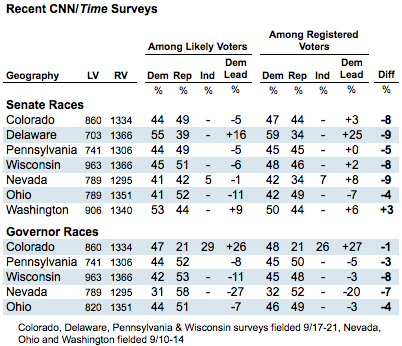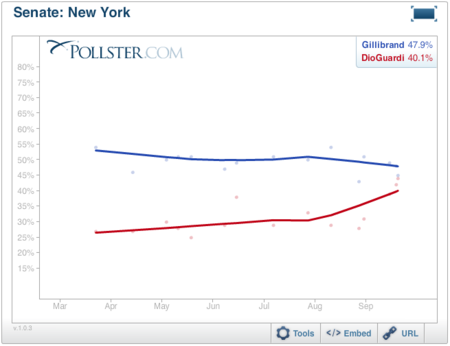
Today's big polling news comes from New York, where two new surveys show much closer results in the races for Senate and Governor than indicated by previous polling, and from four new surveys by CNN and Time in statewide contests elsewhere. But the New York results are the most different from other recent polling and thus likely to get political tongues wagging today. Let's take a closer look.
The two newest polls on New York's Senate contest out this morning come from Quinnipiac University and automated pollster SurveyUSA. Quinnipiac finds Democratic Senator Kirsten Gillibrand leading Republican challenger Joe DioGuardi by just six percentage points (48% to 42%). SurveyUSA shows an even narrower contest, with Gillibrand up by just one point (45% to 44%). Both results represent a sharp break from previous polls, which typically had Gillibrand leading by double-digit margins. Our standard trend estimate which still considers data from previous surveys, now shows Gillibrand ahead by just under eight percentage points (47.9% to 40.1%).
Both surveys also indicate a closer race for New York Governor than other polls taken previously. Quinnipiac has Democrat Andrew Cuomo leading Republican Carl Paladino by six points (49% to 43%), while Survey USA puts Cuomo ahead by nine (49% to 40%). Our trend lines show the race narrowing to a 49.0% to 37.8% Cuomo lead.
******
UPDATE: Just after we published this story, the Siena Research Institute released a new survey showing very different results from those from Quinnipiac and SurveyUSA. Their survey of all registered voters shows Gillibrand leading DioGuardi by 26 points (57% to 31%), and Cuomo leading Paladino by 33 (57% to 24%). While a likely screen would have likely produced closer margins, the differences between the Siena, Quinnipiac and SurveyUSA polls are still enormous and not easily explained.
Our updated trend estimates now show Gillibrand leading by nearly ten points (47.7% to 38.1%) and Cuomo leading by 13.5 (53.2% to 39.7%).
*****
Why the change? The most important factor is probably last week's primary elections in New York, which resolved hard-fought Republican contests for both offices. Previously divided partisans often rally to their party's nominee following a tough primary -- remember the way Barack Obama received an almost immediate boost in polls from Democrats once his battle with Hillary Clinton came to an end in 2008. So some of the change may represent a consolidation of support among Republicans. For example, DioGuardi now receives the support of 88% of Republicans on the Quinnipiac survey and 74% of Republicans on SurveyUSA's poll.
Probably just as important, both polls also represent a shift to likely voter screens. Quinnipiac's previous New York surveys have been among all registered voters, and this poll is SurveyUSA's first in New York for the 2010 cycle. Only Rasmussen had previously applied any sort of likely voter screen to the New York results -- and they also showed both races closer than other pollsters, though not quite as close as these two new surveys.
Also, while the pattern is not consistent, Quinnipiac and SurveyUSA have produced results in recent weeks that are much more favorable to Republicans than likely voter surveys by other pollsters -- in the races for Senate in Ohio and Governor in Pennsylvania for Quinnipiac, and for Senate in North Carolina for SurveyUSA. Nate Silver notes a similar pattern for SurveyUSA in House races.
The impact of likely voter screening on poll results, especially this year, is evident in the four new polls released yesterday by CNN and Time, and in three more they released last week. While their new results largely confirm what we have seen from other recent surveys, CNN and Time are somewhat unique in that they release results for both likely voters and their larger samples of all registered voters. As the table below shows, the difference on the Democrat-minus-Republican margin is often quite large -- as much as 8 or 9 percentage points in Wisconsin, Delaware, Colorado and Ohio.

It is important to remember that few likely voter screens are created equal, as different pollsters often use very different methods to model or screen for what they all describe as "likely voters." And worse, only a handful of pollsters disclose the details of their process. This is an aspect of this year's polling that we will continue to watch closely.

